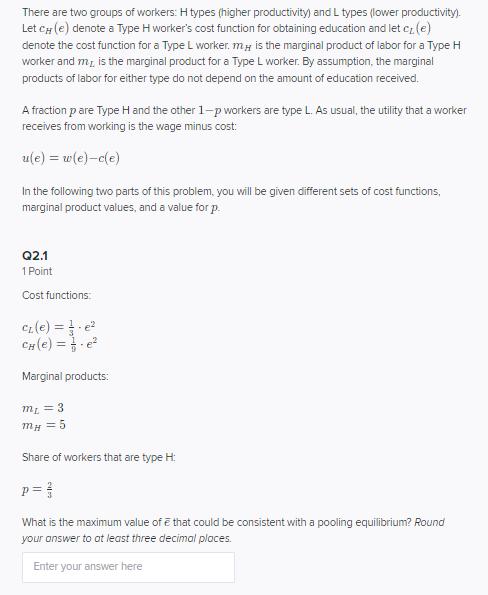Answered step by step
Verified Expert Solution
Question
1 Approved Answer
There are two groups of workers: H types (higher productivity) and L types (lower productivity) Let CH (e) denote a Type H worker's cost


There are two groups of workers: H types (higher productivity) and L types (lower productivity) Let CH (e) denote a Type H worker's cost function for obtaining education and let e (e) denote the cost function for a Type L worker. mg is the marginal product of labor for a Type H worker and m, is the marginal product for a Type L worker. By assumption, the marginal products of labor for either type do not depend on the amount of education received. A fraction p are Type H and the other 1-p workers are type L. As usual, the utility that a worker receives from working is the wage minus cost: u(e) = w(e)-c(e) In the following two parts of this problem, you will be given different sets of cost functions, marginal product values, and a value for p. Q2.1 1 Point Cost functions: CL(e) = e Marginal products: 8= Tu my = 5 Share of workers that are type H: p = } What is the maximum value of that could be consistent with a pooling equilibrium? Round your answer to ot least three decimal places. Enter your answer here Q2.2 1 Point Cost functions: ez(e) = e CH(e) =e Marginal products: m = 2 mH = 6 Share of workers that are type H: p = What is the maximum value of that could be consistent with a pooling equilibrium? Round your answer to ot least three decimal places. Enter your answer here Save Answer
Step by Step Solution
★★★★★
3.52 Rating (155 Votes )
There are 3 Steps involved in it
Step: 1
Answer The Given information ale e CH Ce075e 2 Equili brium whe ther there is a lev...
Get Instant Access to Expert-Tailored Solutions
See step-by-step solutions with expert insights and AI powered tools for academic success
Step: 2

Step: 3

Ace Your Homework with AI
Get the answers you need in no time with our AI-driven, step-by-step assistance
Get Started


